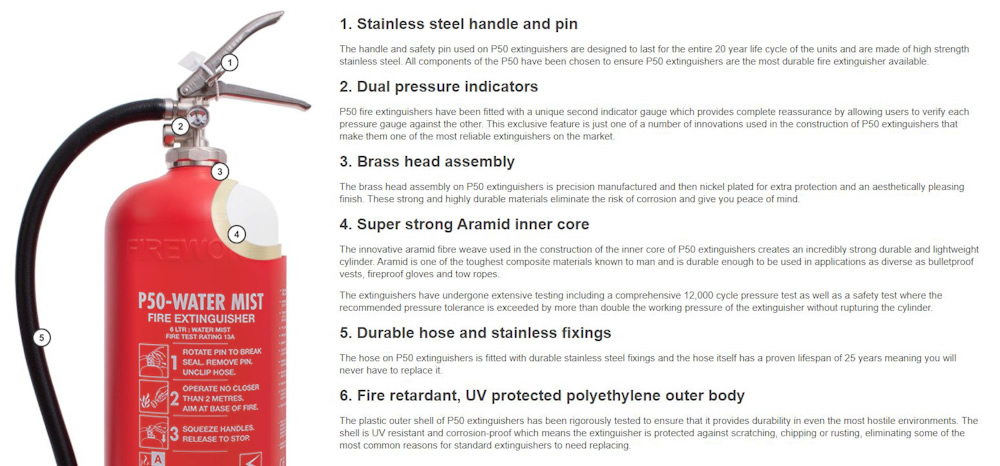Fire & Safety Solutions
CALL OUR TEAM NOW 0800 612 6537
Also FREE from UK mobiles
Free Delivery
on 100s of Products
Secure Payments
with our fast checkout
Online Support
Contact Us Now
30 Day Accounts
for Public Sector
5 Star Customer Feedback
How are P50 fire extinguishers different from other extinguishers?
How are P50 extinguishers built?
P50 fire extinguishers consist of an extruded 5-layered plastic container, which holds the fire fighting media. Fire fighting foams are corrosive and aggressive to metal, so using an inert plastic cylinder encapsules the contents without any chemical reaction between contents and the cylinder. The extinguishers are also pressurised with inert nitrogen gas. This inert storage system allows foams and powders to be kept in working condition for more than ten years. Traditional metal extinguishers, in contrast, have to be emptied and refilled every five years, as their metal walls often react with the chemicals.
Most extinguishers are permanently pressurised to around 12 to 15 bar. To resist this pressure the P50 cylinder is cocooned with aramid fibre, a material five times stronger than steel on equal weight basis. Such protected, the cylinder-aramid assembly is virtually indestructible.
So that the unit also looks like an extinguisher and to protect the cocoon from cuts or UV light, an external plastic cylinder is fitted and a base is added so that the extinguisher can stand upright. The final step is the addition of nickel-plated brass valves, stainless steel handles and a rubber hose.
P50 extinguishers are kitemarked by BSI and are tested to the most extreme of verification tests during manufacture. The extinguishers have to be able to withstand 12,000 test cycles from zero to 25 bar. They are then crushed flat with a blade and are then re-pressurised to 55 bar without being allowed to leak or fail! An incredible amount of safety margin for an extinguisher that is only pressurised with 12 bars!
Multiple safety features are fitted to P50 extinguishers:
- The extinguisher has two pressure gauges instead of one to address the risk of a gauge needle being stuck and displaying the wrong pressure. Even a fleeting glance allows immediately to identify if the gauges display different results
- A pressure release point has been designed on the inner cylinder in case the extinguisher is exposed to extreme heat. While traditional metal extinguishers can explode when exposed to heat, P50s will safely allow the escape of pressure in a controlled manner.
Design of the P50 extinguisher
Traditional metal extinguishers either allow direct contact between the metal and the contents of an extinguisher (eg powder extinguisher) or have a painted/sprayed lining on the inside of the extinguisher if they contain water-based extinguisher media. The lining becomes often detached or can be porous leading to potentially dangerous corrosion which is invisible from the outside until it is too late and the extinguisher explosively discharges. To overcome this issue metal extinguishers must be emptied/discharged, internally inspected and then re-filled with fresh media every five years. Unbelievably, most servicing companies do not re-fill anymore but simply replace extinguishers after just 5 years with a brand-new extinguisher!
With traditional extinguishers only having one gauge, only a service engineer can verify the correct operation of the gauge. They have to drill a hole into the front of the gauge, connect a pressurising tool and visually ensure that the needle moves.
Any dint on a metal extinguisher creates a stress-raiser, a starting point for corrosion and leads to instant condemning of the extinguisher. These design problems of metal extinguishers are the reason for the annual service visits by extinguisher engineers.
As the P50 service-free extinguishers cannot corrode, protect the extinguisher media from ageing and have duplicate gauges, there is no requirement to carry out an annual service.
Instead, the customer carries out a simple visual inspection once a year and records the result on the back of the extinguisher and in their fire safety log book. Any other ‘present-and-correct’ inspection is continued as before, of course.
How do P50 extinguishers differ from traditional metal extinguishers?
Comparison of metal extinguishers and P50 service-free extinguishers:
|
|
Traditional metal extinguishers |
P50 service-free extinguishers |
|
Fire fighting media protection |
Contact of fire fighting media with metal can happen causing the break-down of chemicals and corrosion of cylinder. Requires 5-yearly discharge/refill and visual inspection from inside |
Inert plastic container plus inert gas protect the chemicals and completely prevent any risk of corrosion. |
|
Pressure display |
Single gauge. Can only be verified by pressurising gauge during service visit |
Dual gauges from different gauge production batches allow easy visual cross-verification to ensure that needles are not stuck |
|
Dints |
Any dints or scratches require the immediate replacement of the units, as they could be stress-raisers and can lead to an exploding extinguisher |
The P50 is literally immune to even the most serious knocks, does not dint and will just take up its original shape if compressed. |
|
Annual service |
Annual service visits required |
Once installed and commissioned, no annual visits required for ten years |
|
5-yearly extended service |
5-yearly re-fill, or even worse, 5-yearly replacement with new |
no re-fill during ten years. After ten years, the unit is factory-refurbished and then good for another ten years. |
To find out more about P50 service-free extinguishers, please contact our friendly team on 0800 612 653 or email support@safelincs.co.uk. You can also visit our P50 page for more details or to order the P50.
Reviewed: 14/09/2021 (doc:554 V1.0). Our articles are reviewed regularly. However, any changes made to standards or legislation following the review date will not have been considered. Please note that we provide abridged, easy-to-understand guidance. To make detailed decisions about your fire safety provisions, you might require further advice or need to consult the full standards and legislation.





















